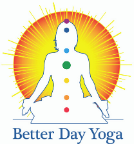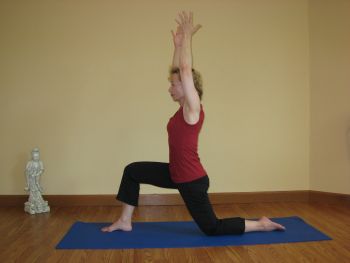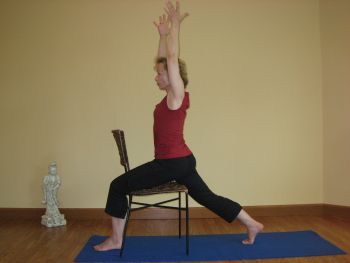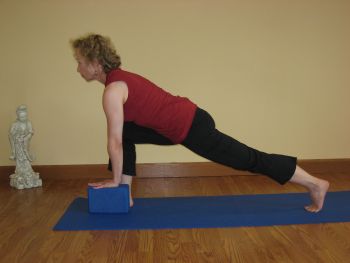
Crescent Lunge/High Lunge/Crescent Moon (Sanskrit term: *Alanasana )
*There is no agreed upon Sanskrit name for this pose.
Low Lunge: (Sanskrit term: Anjaneyasana)
“Anjaneyasana is another name for Lord Hanuman, Hanuman is an incarnation of Lord Shiva who wears the crescent moon in his hair. This posture is also known as “crescent moon”. On a subtle level develops masculine energy in the form of mental power such as determination, willpower, confidence, courage and power.” The site I quoted here is no longer active
I wrote about Hanuman in the opening section. Hanuman didn’t know he had the strength to take the “greatest leap ever taken” until he did it. The take home message here is to believe you have the strength inside as you step into this pose.
Benefits:
- Strengthens: Quads, Hamstrings (legs), upper back, and shoulders (High lunge)
- Stretches: Hip flexors, Quads
- Opens the hips and chest
- Stretches the arms, hip flexors, hip adductors, and calves
- Develops concentration, balance and groundedness
- Improves circulation and respiration, and energizes the entire body
- Relieves joint stiffness
- Tones the abdominal muscles
- Beneficial for sciatica
- Stimulates the sacral chakra—Your sensuality/creativity center—especially in deeper lunges.
- Also stimulates the heart chakra as energy rises from the ground up radiating out of the heart center.
- This pose can be used as a modification for Warrior I when the slight twist of Warrior I is contraindicated.
Alignment cues: There is more than one way to enter into this pose. My favorite is from down dog. From down dog, place one foot forward between your hands, stacking the front knee over the front ankle, feet hip distance apart—basically in a low lunge. Keep your back knee solid but always with a slight micro-bend, and keep the ball of the back foot on the floor. Press your back heel toward the wall behind you keeping the heel lifted enough so as not to injure the Achilles tendon.
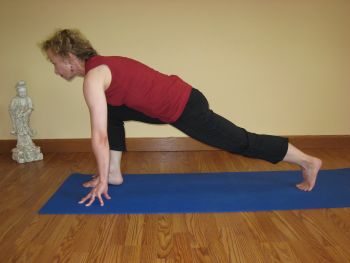
Raise your torso placing your hands on your forward thigh
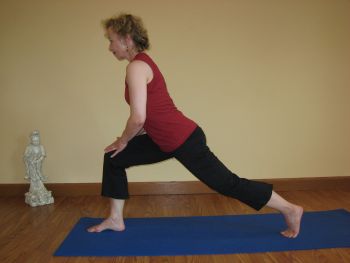
or at heart center in prayer/Namaste/Anjali mudra position
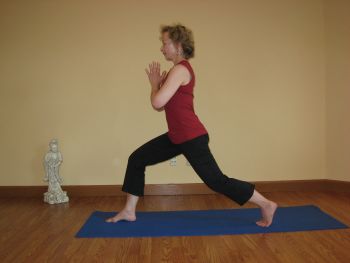
or raise arms overhead with elbows by the ears and dynamic tension in the fingertips

Sink into the hips while pulling your inner thighs toward each other. This keeps the muscles holding the pose vs. the joints. Keep the hips squared. If neck is strained, look down. Tuck pelvis.
For a deeper pose, add a hip socket stretch: Bend the back knee down toward the ground and curl the tail bone under. While keeping the torso at the lower level of back knee down, straighten and engage the back leg to open up the hip socket a bit more in that leg. (Not shown).
Contraindications & Cautions:
- Heart Problems
- High or low blood pressure
- Foot or toe injury
- Achilles tendon injury
- Hip injury
- Arm or shoulder injury
- Severe headache
Beginner’s tip: Still unsure on your form or new to yoga?
- Beginners can walk up the front thigh from the floor, one hand at a time, onto the front knee. (Not shown)
- Beginners can also try kneeling lunge keeping the back knee down on the mat

- Use a blanket under the back knee for sensitive knees, (Not shown)
- Add a chair under the front thigh to improve and help with balance

- Or use a chair or wall in front of you to hold onto—make sure the chair is either fully on the sticky mat, or braced against the wall (Not Shown).
- Reduce the intensity: Stay in low lunge and place fingertips on the floors (See first photo) or use a block to make the floor come closer to you

Variation: 90 degree lunge: This pose was given to me by a Physical Therapist. With the back knee resting on the ground, bring both the back knee and the front knee into 90 degree bends. Then curl the tailbone down and under to therapeutically open the front hip socket. Adding a raised arm on the same side as the back bent knee increases the stretch along the side body, fingers to toes.

For a great side body stretch that also gets the top of the IT Band, reach the raised arm, elbow over ear, toward the bent knee side, using either your same side hand on the top thigh for stability or on a block on the floor next to you for support
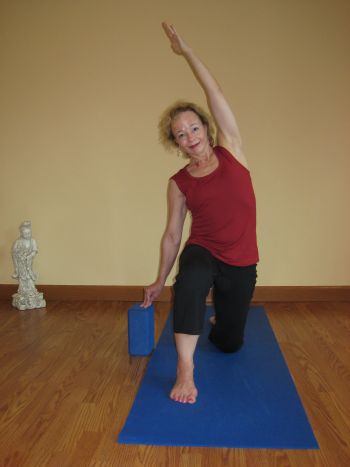
Runner’s lunge/lizard pose variation: (Sanskrit: Utthan Pristhasana)
Bring the hands to the inside of the front bent knee and rest either the palms flat on the ground,
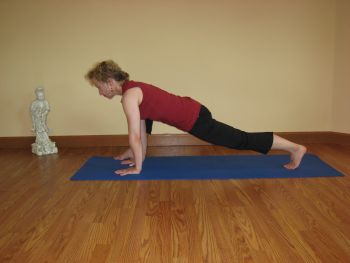
use fists for wrists—knuckles down—if taking care of wrists,
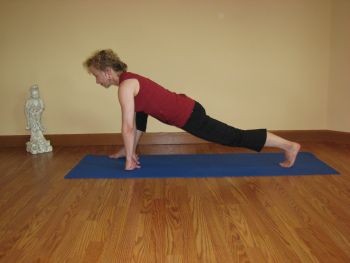 or frog fingers.
or frog fingers.
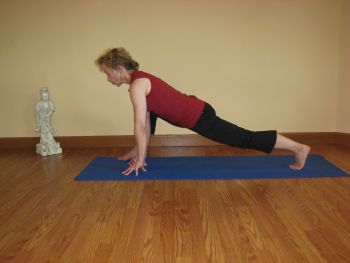
Heel toe the front foot out away from center and leave the toes pointing slightly away from the body so the knee stays over the ankle. To lessen the intensity, add a block under your hands (Not shown). For more sensation, use a block and rest your forearms on the block,
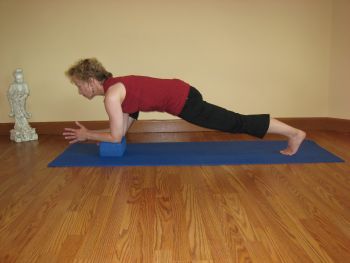
or forearms to the floor (Not shown). Back knee can be up or down depending on your flexibility.
Spiritual aspects of Crescent Lunge: I like to think of a crescent moon when I’m in this pose. In Hatha yoga, Ha mean Sun and Tha means moon. The moon is the receptive, yin, cooling aspect of Hatha yoga. The sun is the active, fiery side. So in crescent lunge imagine the crescent moon and embody the receptive side of your nature. Remember, the crescent moon can be either waxing or waning—building up to the full moon or going down to the new moon. Decide which moon you’re going to be in your practice today, because you always have a choice. You can be the building up your strength and going full-on, or you can be reflective and going within today. You always have a choice.
New moon energy is all about new beginnings, as mentioned in the opening section. So what would you like to manifest into your life going forward? Think of this as you do crescent lunge and add your favorite affirmation as you raise your arms to the sky! Let your heart fill with gratitude, affirm what you are reaching for has manifested, and breathe in new energy! Feel the energy coming into your whole body, visualizing the receptivity of the fingertips as they reach up toward the sky, and the floor contact points of both feet. Visualize the energy moving into your body.
Full moon energy is all about “what are you done with”? Fill the heart with gratitude for the lessons learned and breathe out the energy of the old, releasing it to the Universe. Feel the energy release not only from your heart center, but also your fingertips and toes! Again, visualize the energy of what you are done with releasing away with your exhales.
Sources: http://www.yogajournal.com/poses/2492/ and http://www.yogajournal.com/poses/2494
Beth Shaw’s YogaFit®, The program for a more powerful, flexible, and defined physique, Second Edition
Anatomy of Yoga, Dr. Abigail Ellsworth
